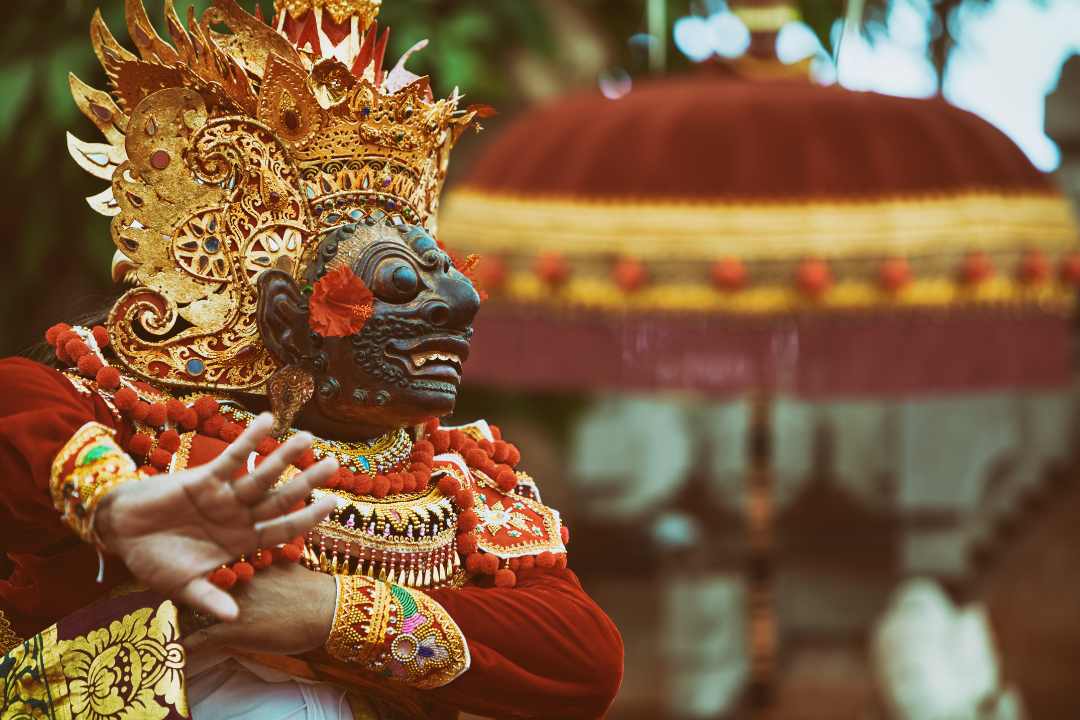Wayang Wong stands as one of the most sacred Balinese dance traditions and thrives across the island. This Bali traditional performance blends ritual, storytelling, and theater, keeping centuries-old heritage alive. The audience enjoys more than entertainment—they experience a direct connection to Bali’s spiritual and cultural roots.
The Roots of Wayang Wong in Bali
Wayang Wong ranks among Bali’s oldest theatrical expressions. Unlike shadow puppetry or barong dances, Wayang Wong features humans wearing masks, called tapel. Dancers bring ancient epics to life through movement, dialogue, and song. The tradition flourished during the 16th and 17th centuries under Raja Dalem Waturenggong. Bali’s rulers strongly supported the arts and treated Wayang Wong not only as entertainment but also as a sacred offering to the gods.
Sacred Rituals Behind the Masks
The Making of Tapel (Masks)
Masks form the soul of Wayang Wong. They serve not only as stage props but also as sacred objects. Mask makers bury selected woods such as pule, tawas, or banoe for decades before carving them. This ritual ensures blessings from the earth and divine approval.
The Kumbakarna mask holds a special place. It radiates mystical energy and stands as one of the most powerful and awe-inspiring symbols of Wayang Wong.
The Sacred Connection
Not everyone can perform Wayang Wong. Traditionally, only people with ancestral ties to past performers earn the right to dance. Further, this practice protects the sacred Balinese dance and keeps it tied to heritage and respect.
The Two Faces of Wayang Wong
There are two main forms of Wayang Wong in Bali today.
Wayang Wong Tejakula (With Masks)
In Tejakula, the performance always uses masks and follows strict ritual guidelines. Moreover, these performances are sacred Balinese dances, often staged in temples during religious ceremonies. They are not designed for profit but as spiritual offerings.
Wayang Wong Without Masks
In contrast, some regions in South Bali perform Wayang Wong without masks. These are more flexible and are usually performed at cultural festivals, art centers, or abroad.
Sacred vs. Ceremonial Performances
Wayang Wong divides into sacred and ceremonial types.
-
Sacred Wayang Wong takes place only during temple rituals. Temples guard the masks as holy objects and never allow them to leave the grounds.
-
Ceremonial Wayang Wong appears at festivals, tourism events, and performances abroad. Artists create special masks for these occasions, separate from temple treasures.
This balance protects the sanctity of the sacred Balinese dance while allowing Bali’s traditional performance to reach global audiences.
Style and Movements of Tejakula Performances
Every Wayang Wong character carries a unique style. Monkey characters leap with nyigcig steps on their toes. Noble heroes move with grace, while giants stomp with heavy, forceful gestures.
Dialogue adds color and texture. Moreover, heroes and nobles speak in Kawi, an ancient Javanese language, while comic servants use Balinese. The contrast between the two languages builds drama and humor.
Music and Atmosphere
Musicians play the Gamelan Batel Wayang, tuned to the slendro scale, to accompany the performance. The rhythms set the mood for dramatic entrances, heated battles, or tender moments.
At times, dancers sing verses from Kakawin, weaving poetry into the story. Music, masks, and movements combine to create an electrifying sacred Balinese dance that touches both heart and spirit.
The Survival of Wayang Wong
After Indonesia’s independence, many traditional arts struggled. Wayang Wong also faced decline as modern entertainment rose. But Tejakula continued to preserve it. Performances are still held in temples, staged during the Bali Arts Festival (PKB), and occasionally presented internationally. This resilience shows the strength of Bali traditional performance and community pride.
Protecting a Living Tradition
Wayang Wong is not only a Bali traditional performance but also a ritual that connects humans, gods, and ancestors. Protecting it means passing knowledge from one generation to the next. Cultural groups, artists, and communities are now training younger dancers, documenting performances, and raising awareness. These steps ensure Wayang Wong remains a living sacred Balinese dance for future generations.
Conclusion
Wayang Wong represents the cultural soul of Bali. It is more than theater—it is ritual, timeless art, and a symbol of community pride. From the mystical craft of mask-making to the powerful temple performances, this Bali traditional performance still stirs audiences today. Visitors who watch Wayang Wong witness living history. This sacred Balinese dance shows that Bali’s identity extends far beyond beaches—it breathes through every temple, every story, and every mask.






Comment (0)